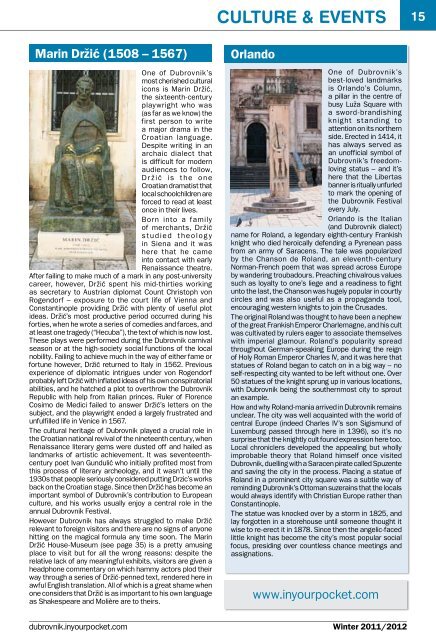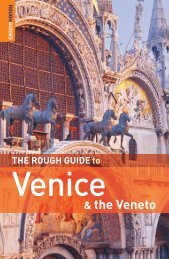Create successful ePaper yourself
Turn your PDF publications into a flip-book with our unique Google optimized e-Paper software.
Marin Držić (1508 – 1567)<br />
One <strong>of</strong> Dubrovnik’s<br />
most cherished cultural<br />
icons is Marin Držić,<br />
<strong>the</strong> sixteenth-century<br />
playwright who was<br />
(as far as we know) <strong>the</strong><br />
first person to write<br />
a major drama in <strong>the</strong><br />
Croatian language.<br />
Despite writing in an<br />
archaic dialect that<br />
is difficult for modern<br />
audiences to follow,<br />
Držić is <strong>the</strong> one<br />
Croatian dramatist that<br />
local schoolchildren are<br />
forced to read at least<br />
once in <strong>the</strong>ir lives.<br />
Born into a family<br />
<strong>of</strong> merchants, Držić<br />
s t u d i e d t h e o l o g y<br />
in Siena and it was<br />
here that he came<br />
into contact with early<br />
Renaissance <strong>the</strong>atre.<br />
After failing to make much <strong>of</strong> a mark in any post-university<br />
career, however, Držić spent his mid-thirties working<br />
as secretary to Austrian diplomat Count Christoph von<br />
Rogendorf – exposure to <strong>the</strong> court life <strong>of</strong> Vienna and<br />
Constantinople providing Držić with plenty <strong>of</strong> useful plot<br />
ideas. Držić’s most productive period occurred during his<br />
forties, when he wrote a series <strong>of</strong> comedies and farces, and<br />
at least one tragedy (“Hecuba”), <strong>the</strong> text <strong>of</strong> which is now lost.<br />
These plays were performed during <strong>the</strong> Dubrovnik carnival<br />
season or at <strong>the</strong> high-society social functions <strong>of</strong> <strong>the</strong> local<br />
nobility. Failing to achieve much in <strong>the</strong> way <strong>of</strong> ei<strong>the</strong>r fame or<br />
fortune however, Držić returned to Italy in 1562. Previous<br />
experience <strong>of</strong> diplomatic intrigues under von Rogendorf<br />
probably left Držić with inflated ideas <strong>of</strong> his own conspiratorial<br />
abilities, and he hatched a plot to overthrow <strong>the</strong> Dubrovnik<br />
Republic with help from Italian princes. Ruler <strong>of</strong> Florence<br />
Cosimo de Medici failed to answer Držić’s letters on <strong>the</strong><br />
subject, and <strong>the</strong> playwright ended a largely frustrated and<br />
unfulfilled life in Venice in 1567.<br />
The cultural heritage <strong>of</strong> Dubrovnik played a crucial role in<br />
<strong>the</strong> Croatian national revival <strong>of</strong> <strong>the</strong> nineteenth century, when<br />
Renaissance literary gems were dusted <strong>of</strong>f and hailed as<br />
landmarks <strong>of</strong> artistic achievement. It was seventeenthcentury<br />
poet Ivan Gundulić who initially pr<strong>of</strong>ited most from<br />
this process <strong>of</strong> literary archeology, and it wasn’t until <strong>the</strong><br />
1930s that people seriously considered putting Drzic’s works<br />
back on <strong>the</strong> Croatian stage. Since <strong>the</strong>n Držić has become an<br />
important symbol <strong>of</strong> Dubrovnik’s contribution to European<br />
culture, and his works usually enjoy a central role in <strong>the</strong><br />
annual Dubrovnik Festival.<br />
However Dubrovnik has always struggled to make Držić<br />
relevant to foreign visitors and <strong>the</strong>re are no signs <strong>of</strong> anyone<br />
hitting on <strong>the</strong> magical formula any time soon. The Marin<br />
Držić House-Museum (see page 35) is a pretty amusing<br />
place to visit but for all <strong>the</strong> wrong reasons: despite <strong>the</strong><br />
relative lack <strong>of</strong> any meaningful exhibits, visitors are given a<br />
headphone commentary on which hammy actors plod <strong>the</strong>ir<br />
way through a series <strong>of</strong> Držić-penned text, rendered here in<br />
awful English translation. All <strong>of</strong> which is a great shame when<br />
one considers that Držić is as important to his own language<br />
as Shakespeare and Molière are to <strong>the</strong>irs.<br />
<strong>dubrovnik</strong>.inyourpocket.com<br />
CuLture & events<br />
Orlando<br />
One o f Dubrovnik’s<br />
best-loved landmarks<br />
is Orlando’s Column,<br />
a pillar in <strong>the</strong> centre <strong>of</strong><br />
busy Luža Square with<br />
a sword-brandishing<br />
k n i g h t s t a n d i n g to<br />
attention on its nor<strong>the</strong>rn<br />
side. Erected in 1414, it<br />
has always served as<br />
an un<strong>of</strong>ficial symbol <strong>of</strong><br />
Dubrovnik’s freedomloving<br />
status – and it’s<br />
here that <strong>the</strong> Libertas<br />
banner is ritually unfurled<br />
to mark <strong>the</strong> opening <strong>of</strong><br />
<strong>the</strong> Dubrovnik Festival<br />
every July.<br />
Orlando is <strong>the</strong> Italian<br />
(and Dubrovnik dialect)<br />
name for Roland, a legendary eighth-century Frankish<br />
knight who died heroically defending a Pyrenean pass<br />
from an army <strong>of</strong> Saracens. The tale was popularized<br />
by <strong>the</strong> Chanson de Roland, an eleventh-century<br />
Norman-French poem that was spread across Europe<br />
by wandering troubadours. Preaching chivalrous values<br />
such as loyalty to one’s liege and a readiness to fight<br />
unto <strong>the</strong> last, <strong>the</strong> Chanson was hugely popular in courtly<br />
circles and was also useful as a propaganda tool,<br />
encouraging western knights to join <strong>the</strong> Crusades.<br />
The original Roland was thought to have been a nephew<br />
<strong>of</strong> <strong>the</strong> great Frankish Emperor Charlemagne, and his cult<br />
was cultivated by rulers eager to associate <strong>the</strong>mselves<br />
with imperial glamour. Roland’s popularity spread<br />
throughout German-speaking Europe during <strong>the</strong> reign<br />
<strong>of</strong> Holy Roman Emperor Charles IV, and it was here that<br />
statues <strong>of</strong> Roland began to catch on in a big way – no<br />
self-respecting city wanted to be left without one. Over<br />
50 statues <strong>of</strong> <strong>the</strong> knight sprung up in various locations,<br />
with Dubrovnik being <strong>the</strong> sou<strong>the</strong>rnmost city to sprout<br />
an example.<br />
How and why Roland-mania arrived in Dubrovnik remains<br />
unclear. The city was well acquainted with <strong>the</strong> world <strong>of</strong><br />
central Europe (indeed Charles IV’s son Sigismund <strong>of</strong><br />
Luxemburg passed through here in 1396), so it’s no<br />
surprise that <strong>the</strong> knightly cult found expression here too.<br />
Local chroniclers developed <strong>the</strong> appealing but wholly<br />
improbable <strong>the</strong>ory that Roland himself once visited<br />
Dubrovnik, duelling with a Saracen pirate called Spuzente<br />
and saving <strong>the</strong> city in <strong>the</strong> process. Placing a statue <strong>of</strong><br />
Roland in a prominent city square was a subtle way <strong>of</strong><br />
reminding Dubrovnik’s Ottoman suzerains that <strong>the</strong> locals<br />
would always identify with Christian Europe ra<strong>the</strong>r than<br />
Constantinople.<br />
The statue was knocked over by a storm in 1825, and<br />
lay forgotten in a storehouse until someone thought it<br />
wise to re-erect it in 1878. Since <strong>the</strong>n <strong>the</strong> angelic-faced<br />
little knight has become <strong>the</strong> city’s most popular social<br />
focus, presiding over countless chance meetings and<br />
assignations.<br />
www.inyourpocket.com<br />
Winter 2011/2012<br />
15







